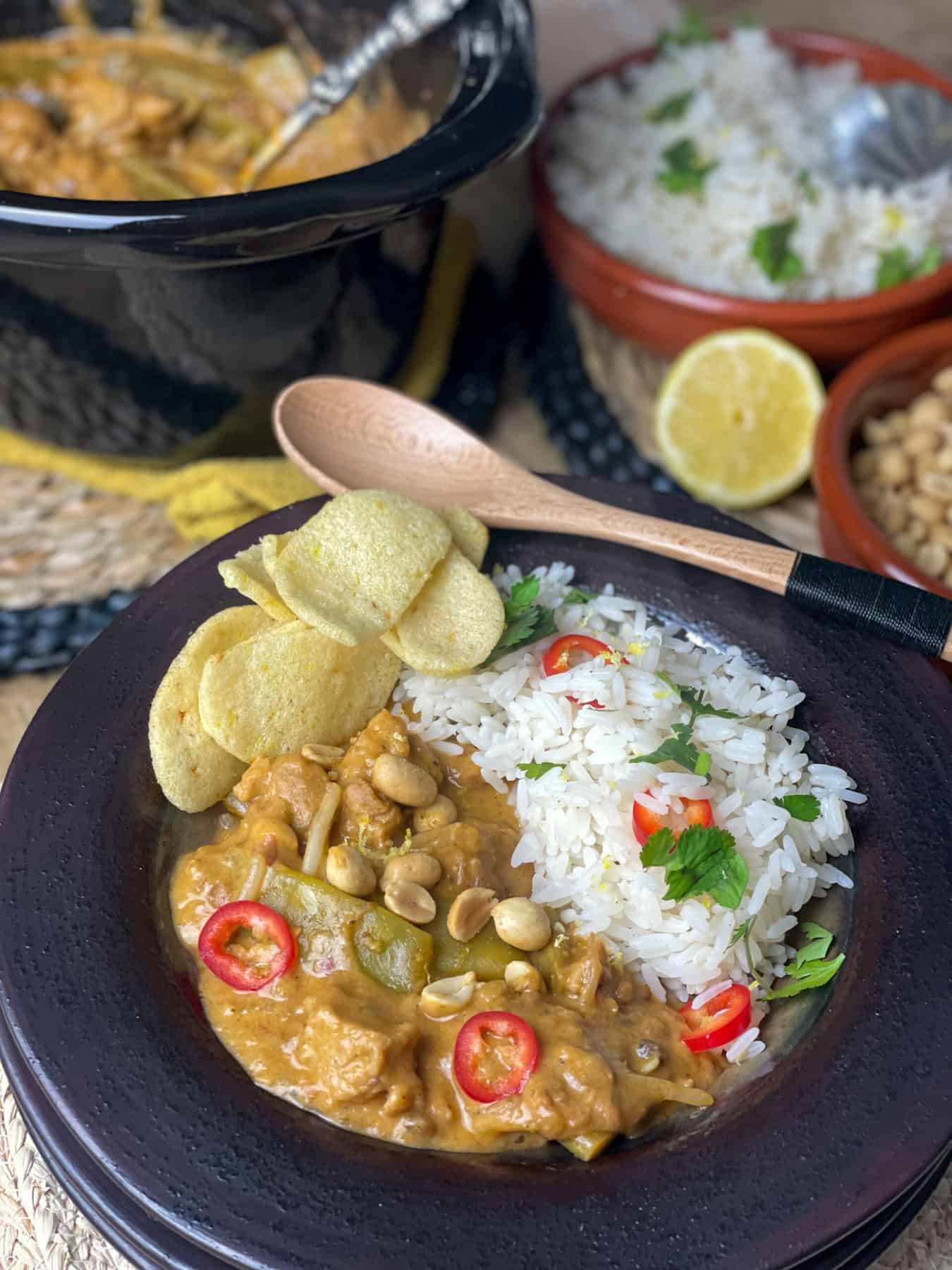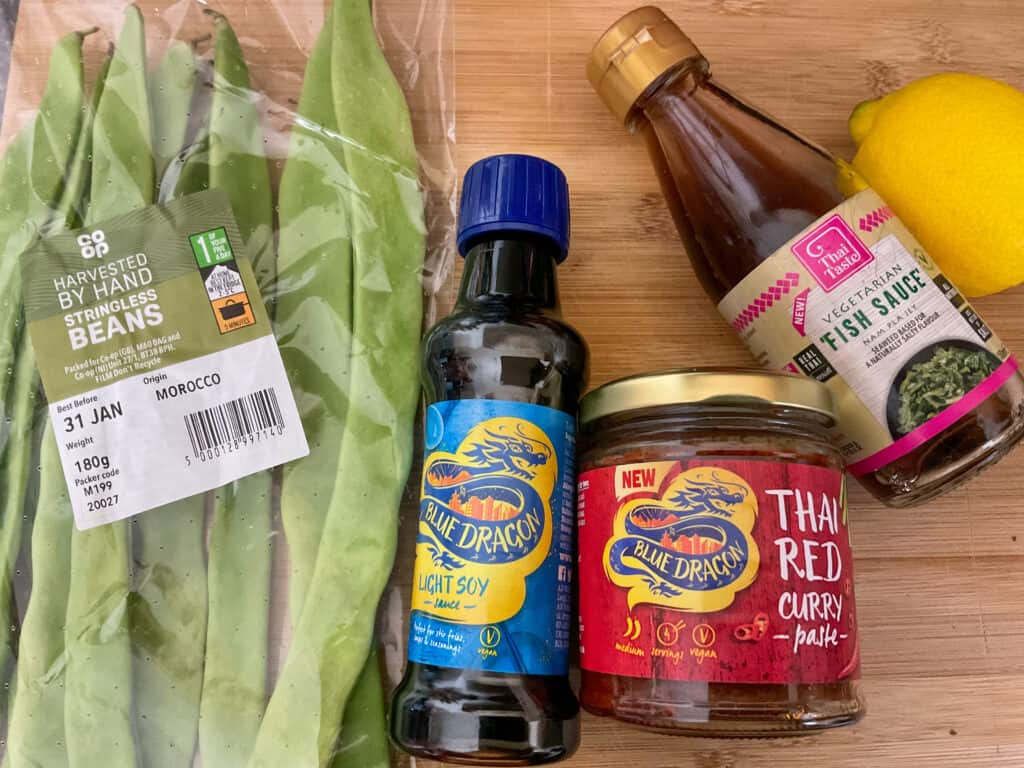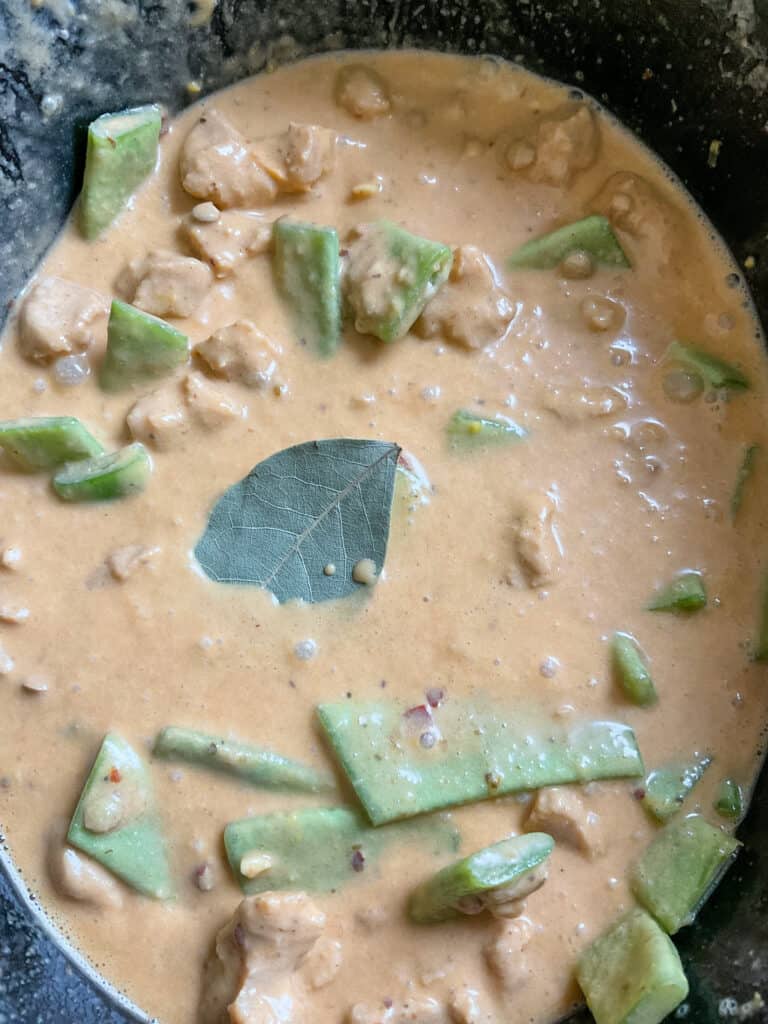Our Vegan Thai Red 'beef' Curry is easy to prepare in the slow cooker (or stove-top) and it features fresh vegetables and textured vegetable protein (TVP) slow cooked in a thick, nutty, savoury, hints of sour, creamy red Thai sauce.

For a delicious and easy-to-make meat-free Thai-inspired meal at home, serve this dish with fluffy rice, crunchy peanuts, fresh chilli peppers, and coriander. Add a squeeze of fresh lemon juice for extra freshness, and a few crispy poppadums for a nice crunch.
Ingredients
The ingredients you will need for this recipe are:
- dried textured vegetable protein chunks (TVP) (or soya curls, or fresh or frozen meat-free pieces)
- vegetable stock
- soy sauce
- Thai red curry paste
- stringless beans (or any long flat beans such as yard long beans)
- lemon
- dried green lentils
- canned coconut milk
- bay leaf
- peanut butter
- vegan fish sauce (or extra soy sauce)
- soft/light brown sugar (or your choice of sugar - coconut or date sugar are good options)
- fresh beansprouts
How to prepare
One of the things we love about this recipe is how quick and easy it is to prepare. With no need to chop onions, garlic, or other vegetables except for the stringless beans which are simply sliced into one-two inch chunks.

Step 1: First, soak the TVP chunks with hot vegetable stock.

Step 2: Gather all your ingredients together and switch your slow cooker to the high setting.


Step 3: Add the sliced green beans, dried green lentils, lemon zest, red Thai curry paste, soy sauce, vegan fish sauce [or replace with an extra tablespoon of soy sauce], light brown sugar, peanut butter, coconut milk, bay leaf, and soaked TVP chunks.


Step 4: Add the vegetable stock that the TVP was soaking in, along with a few pinches or salt and pepper, and give it a good stir.
Step 5: Cook for 3 hours, and then add the bean sprouts. Stir and cook for another 30 minutes.


Optional serving suggestion: Garnish with fresh red chilli slices, fresh coriander [cilantro], and a few peanuts or cashew nuts [toasted nuts are extra tasty]. A few mini poppadoms or naan breads are a nice accompaniment.
Recipe notes
Storage
Store leftover curry for up to 3 days within the refrigerator or 3-4 months within the freezer.
Reheat
To reheat leftover, place the curry into a non-stick pan and bring to the boil, lower the heat and simmer for a few minutes until piping hot. Extra liquid can be added if required, a little oat or soya milk is a nice option, as is almond or coconut milk [although don't use canned coconut milk, the one in the carton intended for drinking is better as it is thinner than canned].
FAQ'S
Stingless beans are similar to French beans and runner beans, and are commonly found in UK supermarkets. These long, flat bean pods contain small green beans and have a fresh, nutty taste. Unlike other types of bean and pea pods, stringless beans do not have a string running along the edge of the pod, making them quick to prepare and easy to eat. They don't require long cooking and can be eaten raw in salads.
Snake beans, or Chinese long beans, are a type of bean commonly used in Southeast Asian cuisine and are a great alternative to stringless beans.
They are long and thin in shape, with a slightly sweeter and milder taste compared to traditional green flat beans. Their name may differ in other countries, with regional variations such as asparagus beans or cowpea beans.
Yard long beans are also a good replacement, as are ordinary green beans, sugar snap peas, and mangetout otherwise known as sugar peas or snow peas. Although, if your alternative pea or bean pods have a stringy component then do remove this before adding to the recipe.
Yes, if you have a preference for a specific type of nut butter or have nut allergies, feel free to substitute peanut butter with your favourite nut butter or opt for sunflower or pumpkin seed butter instead.
Yes, although more vegetable stock will need to be added as the liquid will evaporate faster compared to the slow cooker which tends to retain the moisture. To prepare on the stove-top first add an extra cup (250ml) of stock to the recipe and add more stock whenever it looks like the curry will dry out. You want to end up with a nice thick creamy sauce. The curry will be ready once the lentils are soft, and at this point the bean sprouts can be stirred through. Remove the pan from the heat and pop a lid over the pan. Leave the pan for about 10 minutes and the bean sprouts will warm through in the residual heat.

More vegan curry recipes
We have a lot of family favourite curry recipes that we are exicted to share with you. We especially love this Cauliflower & Potato Curry and this Vegan Chicken Curry. And for a delicious curry soup we always enjoy this Bombay Potato Soup and for a tasty sandwich, tortilla wrap filling, or even just for a fresh curry salad, this Vegan Coronation Chicken is perfect.
For even more vegan curry recipes do have a look at our family collection of Vegan Curry Recipes.
please note: for US measurements click the 'US customary button' within the recipe and the measurements will switch to tablespoons, cups, and ounces.
📖 Recipe
Vegan Thai Red 'beef' Curry [slow cooker & stove-top recipe]
Equipment
- slow cooker [use a 3.5 litre / 3.5 quarts or slightly larger]
- jug [for soaking TVP chunks]
- zester [for zesting lemon rind]
- mixing spoon
Ingredients
Soak:
- 100 grams dried soya chunks [or soya curls or other dried meat-free chunks/pieces, or use fresh or frozen meat-free pieces which will not require soaking]
- 500 mililitres vegetable stock, hot [use a vegan 'beef' flavour stock, if available, such as OXO meat free beef stock cubes]
Curry:
- 180 grams stringless beans [sliced into 1 ½-2 inch pieces]
- 70 grams dried green lentils [rinsed & drained]
- 3 tablespoon red thai curry paste [use a vegan-friendly paste]
- 100 grams peanut butter [crunchy version adds extra texture]
- 1 tablespoon light soy sauce [or dark soy sauce or tamari]
- 1 tablespoon vegan fish sauce [or replace with an extra tablespoon of soy sauce]
- 3 tablespoons soft brown sugar [light brown sugar, or replace with 4 tablespoons of coconut or date sugar if preferred]
- 1 can coconut milk [400g/14oz can]
- 1 bay leaf
- 1 small-medium lemon [remove the zest with a zester]
- 125 millilitres vegetable stock [make this up with the stock drained from the soaked soya chunks]
Add after 3 hours of curry cooking in slow cooker:
- 150 grams beansprouts [fresh sprouted mung beans, can be found in the fresh stir-fry package section in most supermarkets]
Garnish, to taste, optional
- fresh coriander [cilantro], toasted or salty peanuts/cashews, lemon juice, fresh red chilli slices
Instructions
Soak the TVP:
- Add the dried TVP chunks to the hot vegetable stock. Stir and leave to soak for about 30 minutes. Every now and then give the chunks a stir.100 grams dried soya chunks, 500 mililitres vegetable stock, hot
Prepare curry:
- Preheat the slow cooker by switching it to the high setting while you add the ingredients.
- Add everything to the slow cooker: green lentils, coconut milk, stringless beans, red Thai curry paste, soy sauce, vegan fish sauce [or replace with an extra tablespoon of soy sauce], peanut butter, brown sugar, bay leaf, and lemon zest.180 grams stringless beans, 70 grams dried green lentils, 3 tablespoon red thai curry paste, 100 grams peanut butter, 1 tablespoon light soy sauce, 1 tablespoon vegan fish sauce, 3 tablespoons soft brown sugar, 1 can coconut milk, 1 bay leaf, 1 small-medium lemon
- Drain the TVP chunks from the soaking liquid but keep the vegetable stock. Add 125ml of the vegetable stock to the slow cooker. If you don't have enough just add extra water until you have 125ml [½ cup] of stock. [I drained 124ml of stock from the chunks so just required an extra 1ml of water.]125 millilitres vegetable stock
- Add the TVP chunks to the slow cooker.
- Add a few pinches of salt and pepper. Give everything a good stir, breaking up the peanut butter into the sauce.
- Pop the lid onto the slow cooker and leave to cook for 3 hours.
- After 3 hours add the bean sprouts, stir well and leave to cook for a further 30 minutes.150 grams beansprouts
- Remove the bay leaf. Season to taste with salt & pepper, and add a little squeeze of fresh lemon juice if liked.
Serve: [optional suggestions]
- Enjoy with rice, and toasted or salty peanuts/cashews, a sprinkle of coriander [cilantro], and something crispy like poppadum's or naan breads instead.A dollop of vegan mayonnaise or plain yogurt is a nice addition as are a few slices of fresh red chilli and/or sliced spring onions [green onions].
Notes
- Nutritional data does not include garnish or side dishes.
- Leftovers can be stored in the refrigerator for up to 3 days or frozen for 3-4 months.
- To reheat leftovers, place the curry in a non-stick pan and bring to a boil. Cook for 2-3 minutes until piping hot. Add extra liquid if the sauce is too thick such as plant-based milk, canned coconut milk, or vegetable stock.
- Before serving, consider adding a few handfuls of fresh spinach to the curry and letting it wilt for a few minutes.
- This recipe uses Blue Dragon Thai curry paste [which we found in the local Co-Op supermarket]
- The fish sauce used is labeled as vegetarian but is also suitable for vegans.
- If vegan fish sauce is not available, you can add an extra tablespoon of soy sauce instead.
- Any edible bean or pea pod vegetables are suitable for this recipe, including sugar snap peas, yard-long beans, green beans, and mangetout.
- If you have a peanut allergy or don't like peanut butter, it can be replaced with any other type of nut butter, or with sunflower or pumpkin seed butter.
- To prepare on the stove-top: Add an extra cup (250ml) of vegetable stock to the recipe and add more stock whenever it looks like the curry will dry out too much. You want to end up with a nice thick creamy sauce. The curry will be ready once the lentils are soft, and at this point the bean sprouts can be stirred through. Remove the pan from the heat and pop a lid over the pan. Leave the pan for about 10 minutes and the bean sprouts will warm through in the residual heat.
Nutrition
Comments
We would love to know how you got on with the curry recipe so do drop us a comment below. All feedback is very much appreciated and it helps us know which recipes you are enjoying so we can publish recipes that you want and need. Thanks so much. Jacq x
Leave a Reply